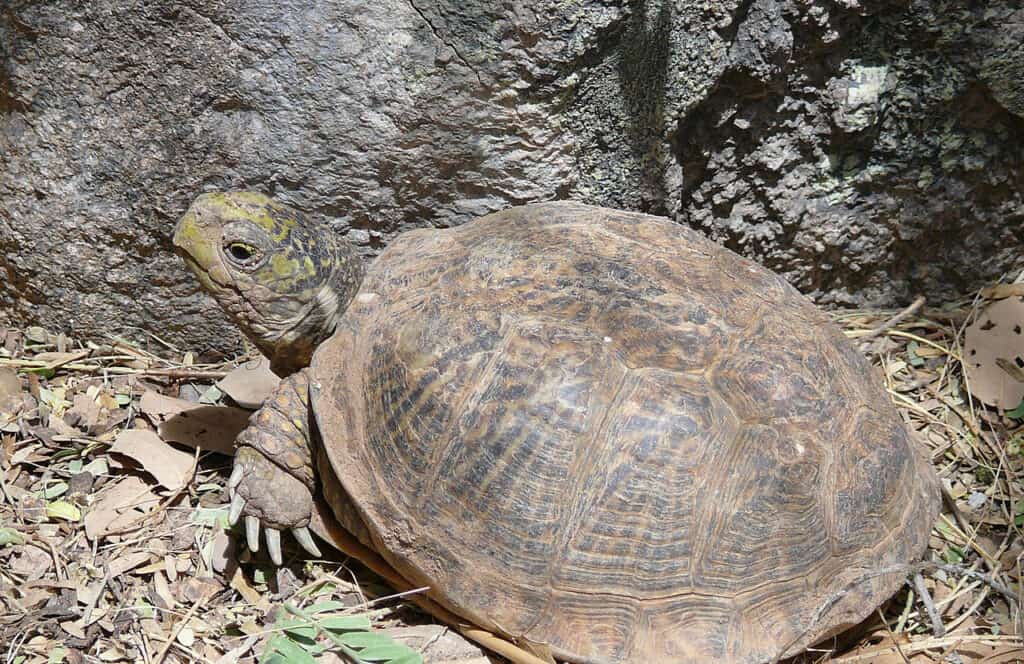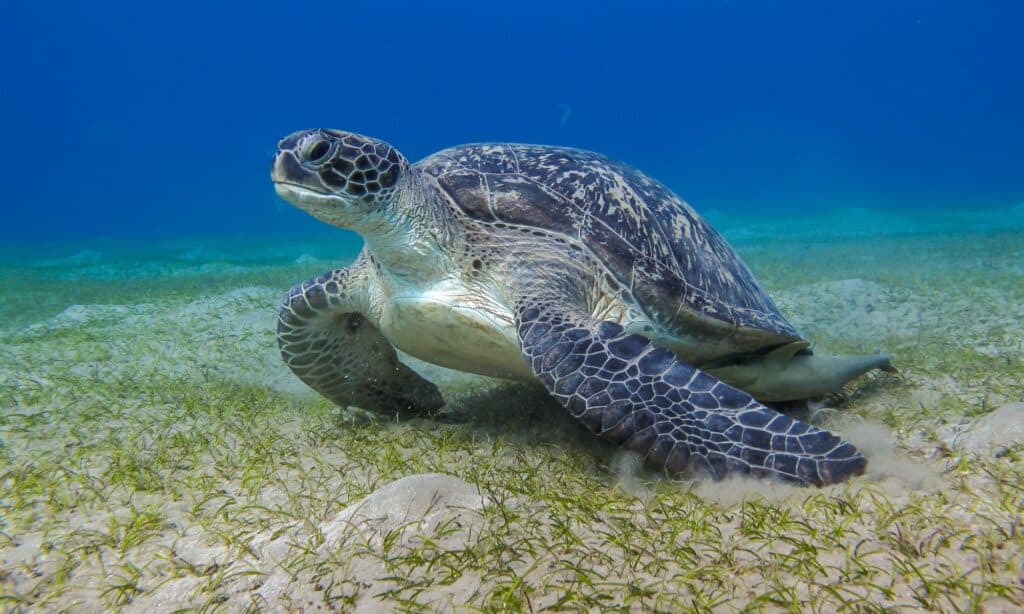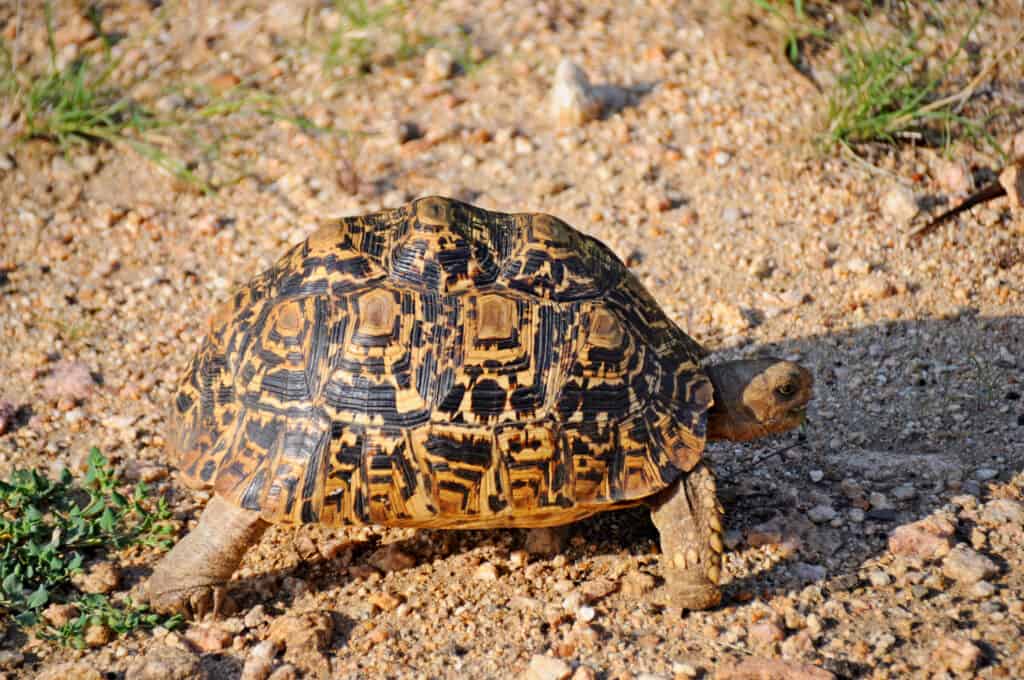Turtles are reptiles that are found on every continent except Antarctica. They make up the Testudines order and are characterized by the domed shell on their back. Most turtles live in and around water, although all nest on land. There are many fascinating things to learn about them – including when they originated, what their shell is made from, and why the nest temperature is important. So join us as we discover 10 incredible turtle facts!
1. Turtles are Divided into Two Groups Based on their Neck
One of the things that turtles are most famous for is their ability to retract their head and neck into their shell. However, turtles are divided into two groups based on how they retract their neck – side-necked and hidden-necked. Side-necked turtles make up the turtle suborder Pleurodira and consist of three different family groups which all live in the Southern Hemisphere. Side-necked turtles bend their neck sideways as they retract it so that their head fits between their front legs. As the neck doesn’t retract fully, their shell overhangs more at the front in order to protect it.
Hidden neck turtles make up the suborder Cryptodira and consist of approximately 266 species across 23 family groups. Cryptodira contains species such as snapping turtles and sea turtles. Hidden neck turtles do exactly what their name suggests and fully retract their head and neck into their shell. They do this by lowering their necks before retracting them straight back. Interestingly, despite being members of the “hidden neck” group of turtles, sea turtles are not able to retract their heads and neck into their shells. This leaves them more vulnerable to predators than other turtles.
2. Turtles Date Back to the Time of the Dinosaurs
Turtles have been around for a really, really long time and even date back to the time of the dinosaurs! They are one of the oldest reptiles in the world – even older than crocodiles, thought to be one of the oldest living vertebrates. Prehistoric turtles originated approximately 230 million years ago, with the first dinosaurs appearing only shortly before. Following this, turtles coexisted alongside dinosaurs for millions of years until the dinosaurs became extinct.
3. Turtle Shells Are Made from their Ribs

Turtle shells are made from their bones.
©Sue in az / public domain – License
Possibly the most surprising thing about turtles is that their shell is actually made up of their bones. Turtles are vertebrates, and their shells are part of their skeleton. In total, the turtle shell consists of between 50 and 60 bones. It is divided into two parts- the upper domed section is called the carapace, while the flat belly section is called the plastron. The carapace is made from the vertebrae and the ribs. Incredibly, ribs bones grow sideways into flat sections which join together and cover the back of the turtle. The shell is then covered in an outer layer made from keratin. Keratin is the same substance that fingernails are made from. Also, contrary to common belief, a turtle cannot come out of its shell. Additionally, they will never outgrow it as it grows with them.
4. Turtle’s Nest Temperature is Important
One of the fascinating things about turtles is how important the temperature of their nest is. This is because the temperature of the nest determines the sex of the hatchlings. All turtles nest on land, and the nest is usually just a hole dug in the sand or soil and then filled in and covered with vegetation. Turtles are not maternal and do not care for their young. In fact, after laying the eggs, they have nothing more to do with them or the subsequent hatchlings.
The number of eggs laid varies depending on the species, but clutches of up to 100 eggs are not uncommon. The temperature of the eggs inside the nest then determines the sex of the turtle hatchlings. In most cases, a cooler temperature produces more male hatchlings, while warmer temperatures produce more females. However, the actual temperature required usually depends on the species.
5. The Size of Turtles Vary Widely
With so many species, it’s not surprising that the size of turtles varies widely, but did you know just how much? The smallest species of turtles are only 3 to 4 inches long, while the largest is the leatherback sea turtle which can be up to 10 feet long and weigh up to 2,000 pounds. Turtles in the past were even bigger, and the largest was the extinct Archelon – a sea turtle that was 16 feet long and weighed almost 5,000 pounds.
6. Some Turtles Migrate Thousands of Miles

Leatherback sea turtles migrate thousands of miles to their favorite nest sites.
©iStock.com/YasserBadr_Beenthere
Many species of turtle migrate seasonally, but most only travel short distances (often between 1 and 20 miles). However, sea turtles migrate thousands of miles yearly to their favorite nesting sites. Incredibly, leatherback sea turtles are one of the most migratory animals in the world and regularly migrate 10,000 miles or more every year between their foraging and nesting grounds.
7. Turtles have no Ear Openings
Surprisingly, turtles don’t have ear openings. Instead, their eardrums are covered with scales. But this doesn’t mean that they are deaf – far from it, in fact. Turtles have very good hearing compared to other reptiles and can hear sounds of up to 500Hz on land. They even have exceptional hearing under the water too and can hear low range frequencies with the best sensitivity being in the range of 200 to 400Hz.
8. Turtles Have No Teeth
Turtles are typically opportunistic omnivores. Those who spend more time on land usually eat more plant material, while those that spend more time in the water – particularly sea turtles – have a more carnivorous diet. Therefore, it might come as a surprise to find that they don’t actually have teeth. Instead of teeth, turtles have a sharp, powerful beak like a bird. They can use this beak to tear off plant material and crush the shells of animals such as clams, crabs, and sea urchins. However, although we say that turtles don’t have teeth, there is one slight exception to the rule – hatchlings. This is because hatchlings have something known as an “egg tooth” which they use to break open the egg with when they are hatching. This isn’t a proper tooth as such, and instead is a small, hard bump that is made from keratin.
9. All Turtles are Cold Blooded

Turtles rely on their environment for their body temperature, so they have to bask in the sun to warm up.
©Don Serhio/Shutterstock.com
As reptiles, all turtles are cold-blooded, which means that their body temperature depends on the environment. However, some species are able to regulate their body temperature better than others. Smaller species have limited ability to do this, so they have to bask in the sun in order to allow their temperature to rise sufficiently, then move back into the shade or the water when they need to cool down. On the other hand, some of the larger species have a large enough mass that they are able to cool down or warm up over a longer period of time – usually several hours. Some sea turtles – particularly the large leatherbacks – are able to maintain their temperature to some extent using countercurrent heat exchange in the blood vessels between their body and their flippers.
10. Approximately Half of all Turtles are Endangered
Unfortunately, approximately half of all turtle species are endangered in some way – including almost all of the sea turtles. Turtles face several very real threats today, with habitat destruction and the destruction of nest sites being among the main reasons. They also face major threats from poaching as they are often killed for their meat and skin while their eggs are also stolen. The fishing industry also threatens turtles and especially sea turtles. This is because they often become tangled in the nets or are caught as bycatch.
The photo featured at the top of this post is © iStock.com/YasserBadr_Beenthere
Thank you for reading! Have some feedback for us? Contact the AZ Animals editorial team.






